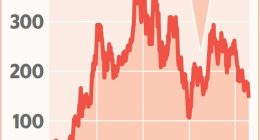If your website takes more than four seconds to load, you’ve already lost a quarter of your visitors.
December 6, 2018 8 min read
Opinions expressed by Entrepreneur contributors are their own.
The ecommerce industry is growing rapidly every year, but that doesn’t mean that all ecommerce businesses are growing at the speed they’d like.
Related: Use These Web Design Tricks to Grow Your Business Exponentially
Whether your sales are actively lagging or just okay, if your business is like most, you want to grow your revenue faster. And, here, good design is one of the most effective growth tools you can put to work to get there.
What does “good design” comprise? It covers nearly every aspect of your ecommerce’s external elements, from your company’s logo design, to your website’s appearance, to your marketing brochures, to the user experience itself. All must be smartly designed. The reason is simple: Poor design will undermine your business.
So, now that (hopefully) you’re convinced that strong, smart design is for you, here are six strategies to help you achieve it:
1. Optimize your website load speeds.
Your ecommerce business is only as strong as your website. If visitors are met with inept design and slow load speeds, they’re going to leave before you’ve had a chance to engage them, much less make a sale. Research from Stanford reveals that 75 percent of internet users surveyed will make judgments about a business’s credibility based solely on how its website looks.
A Kissmetrics infographic, moreover, shows that by the time your website hits four seconds of loading time, you’ve already lost 25 percent of your potential viewers.
To reduce your load speeds, think about what you want your ecommerce website to include. If it’s laden with data-intensive graphics and photos, load times will be longer than what you’ll see with a sleek, cleanly designed website using minimal graphics. Still, the takeaway here is not that you should eliminate photos and graphic elements from your ecommerce website design entirely. Instead, the lesson is to use design elements smartly for maximum impact and quick load speeds.
That’s what Basecamp (project management software) does on its home page and product pages. It uses large fonts, a few smart colors, fun illustrations and great copywriting to explain its product. Its pages load quickly and are highly readable.
Next are those photos: Many ecommerce stores out there remain photo-heavy, and that can be problemmatic. Make sure that you minimize your photo file sizes as much as possible while still maintaining good photo quality.
Related: 7 Deadly Web Design Sins You Might Be Making
Then there’s color: Artful and intentional use of color, white space and text can go a long way to your achieving smart design. Throw in a few minimal brand-specific graphic elements to create a website that is a pleasure to navigate.
But, overall, when you work with your website designer, be sure to communicate that quick load speeds are a high priority.
2. Target existing customers, using remarketing ads and email campaigns.
It’s more cost-effective to sell to existing customers than it is to acquire new ones. If you want to grow your ecommerce business quickly, focus some of your marketing efforts on gaining repeat sales from current customers. Two great strategies for engaging with these people are: “remarketing” ads and email campaigns.
Google’s remarketing ads target users who have already visited your website. This means that the people receiving these ads are those likely to be the most receptive to your message — because they’ve already sought out your business on their own. An eye-catching ad design steeped in your visual brand will help to keep your business on your customers’ minds. Pair that compelling design with a valuable offer, and those existing customers will flock to your site to take advantage.
You might also want to consider reaching out to past customers with an email campaign. Email is still a highly effective tool for contacting customers, especially web-savvy, smartphone-toting customers who are comfortable shopping online.
Just be careful that your email campaigns are well-designed. Here’s an example of one that wasn’t, from the grocery chain Foodtown. The email is too busy and it’s impossible to quickly tell what’s going on. Instead of highlighting everything your company offers, highlight a few key items or services

3. Optimize your ecommerce business for mobile access.
The way people access the internet has changed. Over the years, the number of users accessing the internet from computers has declined, while more and more people access the internet from their mobile devices. As of November 2016, mobile devices became the most popular way to access the internet.
When you build an ecommerce site, it’s wise to optimize it for mobile users. Otherwise, the site will be behind the times and lose you business. After all, there are few things more frustrating than trying to navigate a traditional, desktop website from your smartphone.
Your ecommerce website design should also be responsive. This means that it is designed to visually adjust to the size/shape screen on which it appears. And, the most responsive websites not only adjust to the new screen size, but they’re also intuitive and easy to navigate, as well.
4. Harness the power of the landing page.
If you’re serious about achieving rapid growth with your ecommerce business, you need to embrace the landing page. A landing page is a web page specifically devoted to a single product or offer. And, unlike your traditional website home page, every element is laser-focused on a single call to action and intentionally designed to convert.
So, feature each marketing offer and product with a unique landing page on your website. You may even want to consider creating landing pages for specific target audiences. That way, people who search for your product online will be taken to a web page that caters to their specific needs and perspectives.
When designing landing pages for your ecommerce website, remember to eliminate distractions, provide a clear call to action and make it easy for the customer to complete that call to action.
Below is a good example of an effective how-it-works landing page from QuicklyLegal, an online service that helps entrepreneurs, freelancers and small businesses create, sign and manage legal agreements on any device. There’s a clear call to action (START FREE TRIAL), concise content and useful examples of the product in action.

5. Recover abandoned shopping carts to boost sales.
For every ecommerce store, the shopping cart is the final barrier between a prospective customer and a sale. And, shopping cart abandonment is an issue that all ecommerce businesses face. Customers load up their carts with items, then promptly disappear.
There are many reasons for cart abandonment: shipping price shock, a confusing check-out process and the intent to use the cart for storage for a later purchase. But, great design can help you nudge those almost-sales into actual sales. Start by reviewing your shopping cart design for the following flaws:
- Is it confusing?
- Does it take too many steps to complete?
- Is it slow to load?
- Is the process buggy?
Track the issues you find as you review your check-out process — no matter how small. Even the most minor inconveniences can drive some customers away. These inconveniences are your guideposts for improvement.
Then redesign your shopping cart interface to eliminate the friction points you’ve discovered. Remember that simple is better than complex. And, transparency is better than mystery.
Related: 10 Tips for Web Design That Drives Sales
B&H (audio and video products) does a good job with its shopping cart design. When you add an item to a shopping cart, you quickly see what you’ll pay, the insurance options available to protect your purchase and recommended accessories (based on what other people have bought). You can add accessories and insurance directly from this page without having to navigate to a half dozen other pages.
The overall message here? If you want your business to grow faster, invest in good design. It can help you improve conversions, remarket to existing customers, reach mobile users and increase awareness of your brand. Work with your web designer and graphic designer to find the best way to execute these strategies.
This article is from Entrepreneur.com









